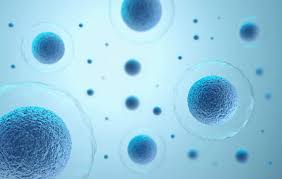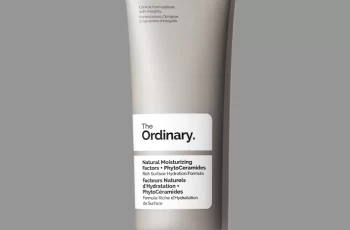Targeting Cellular Senescence and Skin Aging with Skin Care
What are the best skin care ingredients to reduce cellular senescence in aged skin? Keep reading if you want me to explain what cellular senescence is and why it is important when you want to treat wrinkles on your skin and prevent skin aging.
One of the biggest reasons your skin ages is due to inflammatory factors secreted from senescent cells. This aging process is called inflammaging. What are senescent cells and can ingredients in skin care get rid of these cells that cause skin aging?
Cellular Senescence and Skin Aging
How to get rid of senescent cells
Ingredients to decrease cellular senescence
Skincare Products
Cell phases
What are Senescent cells?
What causes cellular senescence?
Senescent Cells and Skin Aging
References
How to get rid of senescent cells and rejuvenate skin?
Preventing cellular senescence is important! Using ingredients that protect skin from pollution and sun radiation and use of sunscreen can help. Anti-inflammatory ingredients and antioxidant ingredients can help prevent senescent cells. Other ways to decrease senescent cells in skin is to stimulate autophagy or activate sirtuin (SIRT-1). (13) SIRT-1 is activated by caloric restriction and by the ingredient resveratrol.
These antiaging skin care ingredients help increase autophagy or decrease cellular senescence
Aquatide™ , also known as Heptasodium hexacarboxymethyl dipeptide-12
Crepidiastrum Denticulatum Extract
Exosomes
Melatonin (14)
Pollux CD™ also known as Crepidiastrum Denticulatum Extract)
Resveratrol (13)
Saururus Chinensis (15)
Ulmus Davidiana (16)
Skincare Products that reduce senescent cells and rejuvenate skin
Plated SkinScience Intense Serum has exosomes. Studies have shown that the number of senescent cells is reduced after using this serum. (refs 16, 17)
Cell phases
You need to understand about the different phases in a cell’s life cycle so you can understand what cellular senescence is and why it is bad for skin.
Skin cells called keratinocyte and fibroblasts go through five different phases:
Stem (Stem cells)- Think of these as embryo cells that will change significantly as they mature.
Proliferation (Proliferating cells)- These are cells that are dividing and “having babies” and making new cells.
Differentiation (Differentiated Cells)- These are cells that are changing into a specialized cell type.
Senescence (Senescent Cells)- These are cells that are not yet dead but are injured and do not function properly.
Apoptosis (Apoptotic Cells)- These are cell going thru programmed cell death. This is nature’s way of preventing cancer by getting rid of damaged cells.
The difference between apoptotic cells and senescent cells is that apoptotic cells are not viable and are eliminated while senescent cells, even though they have gone into cell cycle arrest, stay functional and are not eliminated from the skin. We know that an increased number of senescent cells correlates with increased skin aging.
What are Senescent cells?
Senescent cells have lost the ability to proliferate and function properly but have not undergone apoptosis. (1, 2) The lysosomes and mitochondria of senescent cells have lost functionality. (3) They produce harmful secretions that lead to inflammation and other problems that speed aging. The presence of senescence cells is associated with increased aging and seems to speed aging.
What causes cellular senescence?
Normal aging causes cellular senescence. Loss of mitochondrial autophagy also induces senescence as does activation of the TP53 gene, inactivity of SIRT-1, and short telomeres. NRF2 is a key regulator of the skin’s antioxidant defense system, which controls the transcription of genes encoding ROS-detoxifying enzymes and various other antioxidant proteins. (4) Activation of NRF2 induces cellular senescence via direct targeting of certain ECM genes.
Senescent Cells and Skin Aging
Senescent cells are increased in aged skin (3) due to age-related decline of senescent cell removal systems such as the immune system (5) and the autophagy-lysosomal pathway. (7)
You need to understand a bit about what causes skin aging to understand the bad effects of senescent cells.
You can learn about the science of skin aging here.
Senescent cells cause damage and aging of the skin because they because they communicate with nearby cells sending inflammatory cell signals via:
Matrix metalloproteinases (MMPs)
Growth factors
Cytokines
Chemokines
Matrix-modeling enzymes
Lipids
Extracellular vesicles (EVs).
EVs are lipid bilayer-lined vesicles that can transport functional RNA and microRNA and other modes of communication between cells. (8)
Senescent cells cause a prolonged state of inflammation, known as “inflammaging” (10) which is detrimental to the skin’s appearance. Senescent human fibroblasts secrete proinflammatory cytokines, MMPs and release ROS (11,12) resulting in degradation of the surrounding extracellular matrix (ECM). Loss of the ECM leads to fibroblast compaction and reduced DNA synthesis which disrupts normal cell function and leads to thin, fragile wrinkled skin.
New information is coming out about cellular senescence and what cosmeceutical ingredients are best to treat it. Join us on You Tube or social media to stay current. This is the long interview where Dr. Baumann and Dr. Wyles discuss cellular senescence.
Wondering which skincare products are best to treat your aging skin? Take the skincare routine quiz to build a custom skincare routine from many brands.
DQH Knowledge drop: In your 20s, your skin cell turnover decreases. (Cell turnover is a key component in keeping your skin youthful.) You know what else slows down? Your collagen production. Starting in your 20s, collagen decreases by about 1 percent per year. Should you want to prevent fine lines and wrinkles, start by eliminating behaviors that contribute to premature aging. “If it’s bad for you, it’s bad for your skin,” says dermatologist Michel Somenek.
“Cigarette smoking reduces blood flow to the skin and causes premature wrinkling and a dull skin texture. Making the repeated pursed motion to inhale can also cause smoker’s lines. Alcohol and recreational drugs are toxins for the skin that damage its cellular structure and DNA,” Somenek tells us. “The faster you eliminate vices while you are young, the better chance your skin and body have to recuperate.” Also, adopting an anti-aging routine in your 20s is key. After all, the best offense is a good defense. We spoke to Somenek and experts Joshua Ross and Audrey Kunin to find out more.
Keep reading for the best anti-aging products for your 20s, according to skincare professionals.
Sunscreen
“We all know that the sun is the number one cause of skin aging and starting the prevention in your 20s is very important,” Ross says. “The majority of your sun damage won’t start to appear until you’re in your 30s, so don’t wait until you see it surface or you’ll be behind the curve. Stay ahead of it with a good-quality zinc-based sunscreen worn daily.”
Farmacy Green Defense Daily Mineral Sunscreen
An invisible sunscreen with SPF 30, plus botanical extracts meant to protect skin with tons of antioxidants. Bonus: It’s clean and fine to use under makeup.
Bareminerals Complexion Rescue™ Tinted Moisturizer Broad Spectrum SPF 30
Although we recommend you use your SPF and moisturizer separately, we also understand moments when you don’t have time or energy for that extra step. For those times, this bareMinerals moisturizer is a great thing to have on hand.
Vitamin C Serum
“A great introduction to anti-aging is to start with a vitamin C serum in your morning skincare routine,” Ross says. “It’s a powerful antioxidant that will neutralize free radicals and brighten the skin.” He adds that it’s a great way to counteract the effects of the sun’s harmful rays, which, as previously mentioned, are among the biggest causes of premature aging.
Drunk Elephant C-Firma™ Vitamin C Day Serum
The Drunk Elephant C-Firma is a lightweight serum that promises to give skin a glow by combining the brightening powers of vitamin C with ferulic acid, l-ascorbic acid, and vitamin E. The included sodium hyaluronate is meant to replace hydration loss, so you shouldn’t have to deal with any irritation.
Sunday Riley C.E.O. Rapid Flash Brightening Serum
This potent serum is jam-packed with vitamin C (15 percent, to be exact), which means it’s a potential superstar at both brightening skin and dousing it in antioxidants.
Peptides
Using peptides on your skin has many benefits, says Somenek. “The skin barrier is what defends the body against pollution, UV rays, bacteria, and toxins. It can be damaged by several everyday factors. Using topical peptides aids in building a stronger barrier,” he says. “Peptides comprise elastic fibers, which are a type of protein. These fibers help to make skin appear taut and firm. Peptides can also help repair damaged skin, relieve inflammation, and even out skin tone. Some peptides can kill acne-causing bacteria that is common in 20-somethings.”
Kunin agrees, saying, “Peptides are an excellent entry point for supporting collagen.” She recommends looking for face and eye treatments that contain these collagen-boosting powerhouses.
Charlotte Tilbury Magic Eye Rescue Cream
This Charlotte Tilbury super-emollient eye cream has a base of coconut oil and shea butter (read: it’s incredibly hydrating). Botanicals plus peptides are meant to help reduce dark circles and boost collagen, respectively.
This creamy moisturizer serves up potent collagen-boosting peptides and pycnogenol, and antioxidant-rich vitamin C. “Instead of sitting on top of the skin, peptides penetrate the outer layer so they go deep. The ‘signals’ they send tell the cells to produce elastin and collagen, which are needed for youthful-looking skin,” explains Somenek.
At-Home Peel Pads
Remember that skin cell turnover fiasco we talked about earlier? One way to help support it is by exfoliating. “Exfoliation is important to help keep skin fresh and luminous,” Kunin says. She recommends using at-home peel pads as an easy and effective way to exfoliate.
“The goal in your 20s is to fight the slowing pace of cell turnover. It is wise to use products that gently exfoliate, yet still remove oil and other impurities. Products that have Alpha Hydroxy Acids (AHA) or Beta Hydroxy Acids (BHA) are a good choice.”
According to Somenek, you should only exfoliate two to three times a week. “People of all ages are guilty of over-exfoliating and that can be too much of a good thing,” he says.
Dermadoctor Kakadu C Intensive Vitamin C Peel Pad
A few swipes of this Derma Doctor powerful peel pad promise to leave your skin glowing and smooth, thanks to the seven (yes, seven) types of chemical exfoliants, including AHA and BHA. It also contains vitamin C via Kakadu plum extract for added brightening and antioxidant protection.
KEY INGREDIENTS Kakadu plum extract is sourced from the Kakadu plum, a fruit grown in northern Australia. It contains vitamin C, which restores the skin’s natural barrier, increases collagen production, and soothes irritation.
Dr. Dennis Gross Skincare Alpha Beta® Universal Daily Peel Pads
These are the gold standard of peel pads, with a cult following and over 900 five-star reviews on Sephora. They’re easy to use and contain a blend of anti-aging exfoliating acids.
Emollient Night Cream
“In your 20s, you need to start upping the hydration in your skincare routine. You may have been cautious of over-moisturizing because of acne in your teens, but as you enter your 20s, your skin transitions and becomes drier,” Ross says. “I recommend an emollient night cream added into your evening skincare regimen.”
“Twenty-somethings need to make sure that they are not using creams that will clog their pores and cause excess oil production,” says Somenek. Opt for non-comedogenic products.
Cerave Skin Renewing Night Cream
One great choice is the CeraVe Skin Renewing Night Cream, which is a non-comedogenic night cream that leaves skin soft and glowy. It combines the moisturizing powers of ceramides and hyaluronic acid.
RoC Retinol Correxion Max Hydration Creme
“The best night cream ingredients contain retinol, benzoyl peroxide, and/or salicylic acid or hyaluronic acid. The goal is to moisturize, yet remove excess oil,” says Somenek. This Roc Retinol Correxion cream fits the bill as it contains both hyaluronic acid and retinol so it promises to moisturize while also being non-comedogenic.



